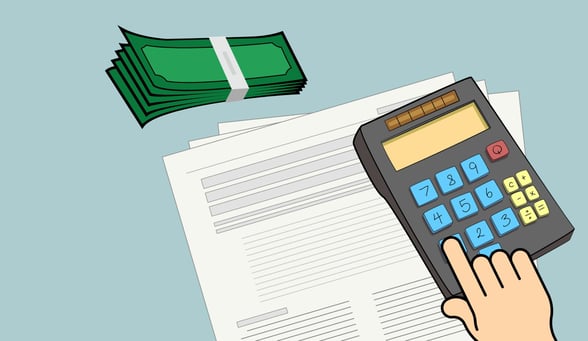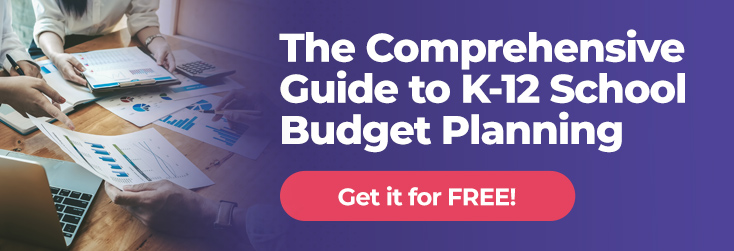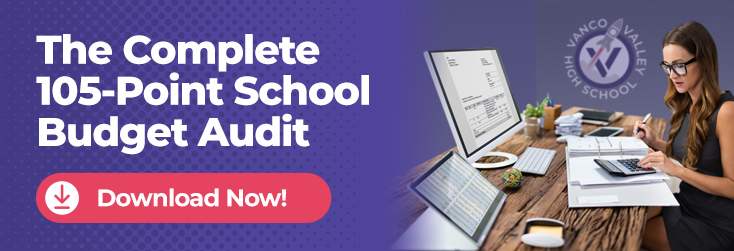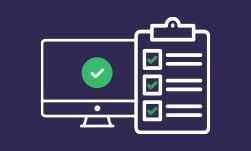
Financial management isn't a glamorous task, but it is nonetheless crucial for schools to help students reach their full potential. Whether you're focusing on a private school endowment fund or budgeting for a public school's arts program, it's worthwhile to take some time and ensure you fully understand how school accounting works.
The most basic definition of school accounting is tracking all of the transactions involved in running the school. This is mainly going to involve revenues, expenses and any changes in value of school assets. Without proper accounting, schools can run into financial trouble because they may not be able to afford essential expenses or necessary updates to their school property.
Another important role that a school accounting system plays in educational management is ensuring compliance with all applicable laws and regulations. These laws and regulations may include how donations are managed, what charitable contributions may be tax exempt and more. Before you make any final decisions about financial management for your school, it's important to familiarize yourself with any laws or regulations you will need to consider.
Table of Contents
- Key Components of School Financial Management
- Best Practices for School Financial Management
- How to Create an Efficient School Budget
- Financial Reporting and Transparency
- Compliance and Auditing in School Finance
- Integrating Vanco Solutions in School Accounting
- Case Study in Financial Management in Education
- Key Takeaways: Elevating School Financial Management with Technology
- FAQs
Key Components of School Financial Management
.jpg?width=588&height=392&name=School%20office%20worker%20about%20to%20take%20notes%20on%20finances%20(2).jpg)
Before you start feeling overwhelmed, know that there are ways to streamline school financial management. We are going to go over the key components you need to do as a person in charge of this process as well as best practices and case studies so you can put your best foot forward.
Budgeting and Planning
The first thing you are likely to think of for school financial management – and really, financial management of any kind – is budgeting and planning. There’s a reason for the old saying, “If you fail to plan, you plan to fail.” This step is a great opportunity to get all the expected revenue and expenses for your school on paper or in a spreadsheet so you can plan accordingly for the upcoming fiscal periods. To learn more about how to set up a budget for your school, check out this ebook.
Revenue Streams in Education
There are a few main revenue streams in education. Not all of these may apply to your school, but in general, schools can get revenue from governmental fund types, seasonal fundraisers and payments for tuition or fees.
Public schools usually get funding through property taxes, which makes up the majority of their revenue. These taxes are collected by the government and then distributed accordingly. If your school receives property tax dollars, consider reviewing previous years’ records to see how much you usually get and when it is distributed. While the exact amount and date likely vary from year to year, this will empower you to make a safe estimation of how much your school can expect.
Another major source of revenue for both public and private schools is seasonal fundraisers. If you aren’t already planning them, some popular ideas for fundraising events on campus your school should consider are:
- Read-a-thon: It encourages students to improve their reading skills and raises money for your school, making it a great opportunity for a double win.
- Book fair: Students and their families can come to check out displays of a variety of books at different grade levels and purchase their favorites.
- Silent auction: Local businesses and other community organizations can donate products, gift cards, experiences and more to be auctioned off to raise money for the school. This usually benefits the businesses or organizations by raising awareness of what they do and benefits the school because it’s a relatively low-cost fundraiser to put on.

Last but not least, your school may get revenue through tuition and fees that students and their families pay. In addition to regular cost of tuition payments that are particularly common for private schools, your school may earn revenue through transportation fees, lunch payments or even people renting out school property for other organizations or activities. Much like tax revenue, you may want to review the last few years’ data to see how much you can expect to earn through these programs.
Expenditure Management
Once you have an overview of the revenue your school can expect, it’s time to plan how you can use that revenue to pay your expenses. Some of the highest expenses schools can expect include payroll, property maintenance, supplies and, in some cases, scholarships for students in need. Here are some important things to factor in for each of these types of expenses.
- For payroll expenses, a bit more goes into it than just each teacher, administrator and custodian’s gross salary. Your school may also need to pay taxes, fees to a payment processor or the additional costs of benefits such as pensions and health insurance.
- For property maintenance, consider both regular wear and tear and emergency scenarios. Wear and tear property maintenance may look like mowing grass, replacing worn-out lockers or bookshelves or repairing desks and chairs in classrooms. In addition to these expected property maintenance expenses,plan for what to do if something major happens that requires immediate repair, such as a fire or burst pipe. Because not addressing these things quickly can risk student and staff safety, it’s useful to set some money aside just in case the worst happens.
- Your school’s needed supplies will likely span a few categories. You will need school supplies for students, such as pencils, paper and textbooks. In addition, you may need office supplies for teachers and administrators, like three-ring binders or index cards, as well as supplies for the machines they use, such as printer ink. Your custodian workforce will likely need to refill cleaning supplies regularly, such as sanitizing sprays, multipurpose cleaners and paper towels. Be sure to factor in all of the supplies your school needs, and if possible, shop around for the best deal.
- Last but not least, consider scholarships and their additional costs. Your school might offer scholarships for participation in extracurricular activities, the cost of tuition or even field trips. What you offer likely depends on what you charge and the level of financial need in the population you serve.
Best Practices for School Financial Management

Now that we’ve reviewed some of the most common types of revenue and expenditures you’ll need to plan for, it’s time to dive into the best practices to implement to make everything as simple and impactful as possible.
Effective Strategies for Financial Planning and Management
One of the first and most important strategies you’ll want to use is creating a budget and a system for tracking how close you are to that budget at any given time. To ensure that your budget is as accurate as possible, consider using an average of expenses and revenue across the last five years to estimate what your finances will look like this year. When you must estimate, always try to estimate that revenue will be lower than expected and any additional costs will be higher than expected. This gives you a buffer so in the worst-case scenario, you will still have enough revenue to cover your basic expenses. In the best-case scenario, you will have some money left over at the end of the year for long-term goals.
Speaking of long-term goals, make sure you have a plan for those goals and any long-term expenses as well. For example, chances are you won’t need to replace all of the ovens in your school cafeteria every year, but that’s a major additional cost when it pops up. Try to gather data about any major equipment purchases and how long those items usually last and add equipment replacement funds to your budget.
You may also want to plan financially for fun long-term goals, such as upgrading your sports equipment or expanding your theater program. The sky is the limit, especially if you have some motivated students!
Tips for Financial Sustainability in Education
To keep your school’s finances sustainable, you may want to consider cutting expenses or adding revenue sources wherever possible.
- Cutting expenses may include finding areas for increased efficiency, such as reducing wasted food in the cafeteria or finding administrative tasks you can automate. It may also look like rightsizing your staff. If you are experiencing lower enrollment rates, it may be time to consider reducing hours for some staff members or eliminating some positions entirely. While this can be a painful decision, it’s an important step to ensure the long-term future of your school and its ability to serve students.
- Adding revenue sources may look like adding after-school programs that parents can pay for, charging a fee for services like school buses or renting out your facilities on weekends when they are not needed for school use. Consider connecting with your local park district, religious organizations and other family-friendly activity hubs to see if anyone could use a space to gather or may want to host an event on campus.
How to Create an Efficient School Budget

Now that we’ve gone over some big-picture strategies, it’s time to get down to the details. Here are some ways you can implement the strategies discussed above and more for your school.
To effectively manage your school’s finances, you’ll want to create some detailed financial reports on a recurring basis. Many schools do this monthly, with summaries divided up by fiscal periods. As we discussed above, retroactively doing this if accounting and financial reporting aren’t available from past fiscal periods can help with planning. Similarly, keeping this data can inform future reporting periods and ensure compliance.
Once you have the accounting and financial reporting in front of you, it’s time to identify any expenses that might be unnecessary or redundant. For example, if you are consistently spending on backstock of both school supplies and office supplies, you may want to consider combining your backstock storage to reduce unnecessary spending on mutual items like pencils and printer paper.
Depending on how much you can reduce expenses, you may have more room in the budget for various goals and objectives to improve the school. Consider creating a list of the goals your school wants to achieve in the next one to five fiscal periods and adding a line item to contribute to them in order of priority. You may call this a “goal fund” to keep it general or add a specific line item for each goal.
For general expenses and long-term goals, it’s important to include plenty of buffer in your budget. Expenses may go up or appear unexpectedly, revenue may fall short of previous years or you may miss something in your budget. Ensuring that more than enough money is allocated for all necessary spending will allow you to handle these sudden changes with ease and keep your school’s finances as sustainable as possible.
Financial Reporting and Transparency

Now that your budget is set and your goals are in order, it’s time to plan to report these numbers to any relevant parties. This may include federal, state and local governments, unions that employees are a part of and parent organizations that exist to support your school. The level of transparency you commit to may vary depending on whether you are a public or private school, so it’s important to understand the expectations of each group you report to.
The Importance of Transparency in Financial Reports
Financial transparency can benefit an organization in several ways. While it may be required by certain stakeholders, such as the C-suite or the board of directors, it can be beneficial to extend financial transparency to employees as well.
By sharing financial information with employees, it is possible to increase buy-in from everyone. After all, transparency with the budget, expenses and more can show how the educational institution will achieve certain goals that benefit everyone. This can motivate employees to conserve school resources and work as efficiently as possible to avoid adding expenses that will prevent you from reaching your educational institution’s short- and long-term goals. It may also encourage people to be proactive when they see an opportunity to reduce expenses or expand revenue-generating programs and fundraisers.
Tools and Methods for Effective Financial Reporting
There are three main types of reports you may want to use for accounting and financial reporting: an income statement, a balance sheet and a cash flow statement.
At first glance, an income statement and cash flow statement may look like the same thing. However, they do have some important differences, which are mainly because the cash flow statement does not account for any non-cash activities. For example, the depreciation of school assets would not be tracked on a cash flow statement. However, it can still be a good tool to see where money is coming from and going to and get a quick snapshot of the educational institution’s finances.
A balance sheet is usually more detailed and includes information not just on how balances change in a given month but also on assets, liabilities and trends over time.
You may not be required to use all three of these types of reports in your accounting and financial reporting, but it’s a good idea to keep all of them on hand if possible. Regardless of which ones you prefer, always use generally accepted accounting principles (GAAP). These practices help ensure that it’s possible to directly compare accounting and financial reporting from different organizations and may be helpful if you need to get a loan sometime down the road.
Compliance and Auditing in School Finance

Here’s what you need to know to ensure you comply with relevant laws, regulations and program requirements.
Legal Compliance in School Accounting
If you are managing finances for a college, you are likely enrolled in Federal Student Aid (FSA) programs. If you are unsure whether that applies to you, double-check with your school’s financial aid office to see what governmental fund types you have access to. If FSA applies to you, you will need to follow FSA standards and submit to annual accounting and financial reporting and auditing.
For other educational institutions, compliance can vary widely based on where the schools are. If you have questions, consult your school’s leadership to learn more.
School Finance Audits for Financial Integrity
Outside of legally required audits, many educational institutions may choose to use finance audits to ensure financial integrity. This can help with transparency and honesty and simply ensuring that each and every dollar is accounted for.
If your school hasn’t done an audit recently, here are some quick tips to help you get started.
Integrating Vanco Solutions in School Accounting
If juggling all these responsibilities feels overwhelming, you’re not alone. We’ve specifically built our platform to be an easy, community-centered solution to make life easier for people just like you. In addition to streamlining your work to plan, track and audit your school’s finances, this technology can also improve transparency and help everyone do their part to support the mission.
The right accounting software solution can also make life easier for students’ parents and guardians. No more missing a payment because a bill got buried in a child’s backpack! Using an easy online platform, you can help parents keep track of what they owe and make payments quickly as they come up.
Case Study in Financial Management in Education
There’s a reason that Vanco’s school finance solutions are trusted by over 1,000 school districts. No matter what role you play in your school’s finances, our platform can make your life easier and help you reach your financial goals.
From easy finance tracking to removing the hurdles associated with paper bills and cash payments, we can help your district. Waukee Community School District is one of the fastest growing school districts in Iowa and needed help streamlining payments for their 11,000+ students. Now, they are nearly cashless and paperless, saving labor and time by using RevTrak. The benefits of the switch will continue into future reporting periods.
Key Takeaways: Elevating School Financial Management with Technology

School accounting
takes a lot of work, but it’s also extremely rewarding. From analyzing past financial data to making changes that support your district’s long-term goals, the right financial information in the right places can make all the difference.
Efficiently managing everything from budgeting to payment tracking is crucial to keep your school district running, but it’s nearly impossible to do it all on your own. No matter how many spreadsheets or documents you work with, there’s room for human error as bills get lost in the mail, cash gets miscounted and other common mistakes pop up.
What could you do with an extra few hours each week once your school’s finances are squared away?

FAQs
How do school budgeting practices differ from corporate budgeting?
School budgeting practices have different legal requirements than corporate budgeting. However, both use accounting and financial reporting tools like cash flow statements and are required to comply with federal, state and local regulations.
What are the most challenging aspects of financial planning in schools?
Some of the most challenging things schools need to plan for include emergency preparedness, transportation expenses and varying revenue depending on taxes, enrolled students and the success of fundraisers.
How can technology enhance financial reporting and transparency in schools?
Technology can enhance accounting and financial reporting in schools by improving the accuracy, speed and availability of data. It can enhance transparency by offering people at varying levels of involvement access to accounting and financial reporting.
What common legal misconceptions exist in school accounting?
One common legal misconception in school accounting is that there aren’t specific standards or regulations that school districts must follow. At every level of education, there are checks and balances in place to ensure that finances are being handled ethically and efficiently.
What unique benefits do Vanco’s solutions offer for school financial management?
Vanco’s solutions empower people at every level of involvement, from a parent quickly paying a bill to full-time staff raising funds, with a clear view into what is going on and how the choices they make can make a difference for students.
Elevate Your Budgeting Journey with Our Free Template!
Embark on a transformative journey from budgeting novice to expert with our free template. It's not just about planning; it's about achieving unparalleled financial insight and strategy.














